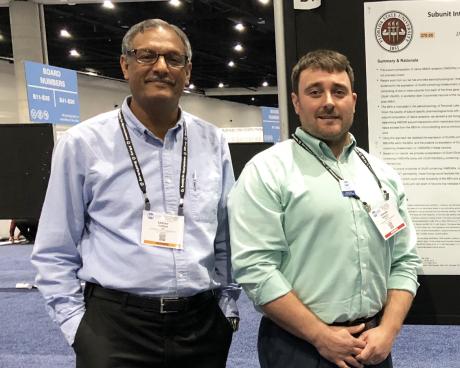Kumar Lab breaks ground – again – in temporal lobe epilepsy research


The Kumar Laboratory at the Florida State University College of Medicine continues breaking ground in its decades-long research of temporal lobe epilepsy (TLE), identifying and isolating vulnerable cells and circuits within the brain to help create better treatments. TLE is the most common form of epilepsy in adults and is often unresponsive to medications currently available.
Having previously discovered a link between a protein in the brain and an increased chance of neurodegeneration in people with TLE, the team of Professor Sanjay Kumar, Research Faculty Stephen Beesley and Associate Professor Akash Gunjan set out to illustrate how the proteins within an NMDA (N-methyl-D-aspartate) receptor interact. It is one of the receptors for the chemical messenger glutamate, an amino acid and neurotransmitter that is important in regulating calcium influx into cells. Too much calcium damages cells and can lead to cell death.
They used a high-resolution microscope and then immuno-stained four different subunit proteins with highly-specific, fluorophore-tagged antibodies. The different colors allowed them to see if, how and when the various subunit proteins interacted with one another.
“This is game-changing!” Kumar said. “Previously, receptor subunit composition was determined using cell biology, electrophysiology and/or pharmacology. But this is the first study to visually demonstrate subunit composition that sheds light on the receptor’s capabilities, and it represents a major advance in the field. This research was done in the spirit of ‘seeing is believing.’ “
They were also able to determine that the expression of these subunit proteins was post-synaptic, contradicting the prevailing hypothesis that these receptors were expressed pre-synaptically.
"The subunits used at glutamate receptors have long been known to determine receptor function,” said Richard Nowakowski, chair of the Department of Biomedical Sciences at FSU’s College of Medicine. “Being able to see (literally!) the subunit composition present in different parts of the brain will revolutionize our ability to understand regional functional differences."
The results of their research were published in Frontiers in Synaptic Science in May 2023, with Kumar as senior author and Beesley as first author. As of August, the article had been viewed and/or downloaded more than 10,600 times, more than 94% of all articles published in the Frontiers series, according to the metrics display on its website.
Four different subunit proteins come together to form the novel NMDA receptor, also known as the “FSU receptor” because it was discovered in the Kumar lab. The follow-up research connected it to the initiation and progression of TLE.
“We were able to see NMDA receptors with differing subunit compositions on neurons in tandem,” Beesley said.
Seeing it provided context to what had been a collection of dots, known in the field as subunit puncta.
Kumar called Beesley “the man behind the work,” whose skills in accessing hard to reach areas of the brain allowed the team to discover that one of the subunit proteins in the receptor was distributed differently than the other two. This helped researchers narrow their focus and aided in showing exactly where neurons were dying and in how large an area.
The article that established that link between the specific brain protein and neural degeneration was published in the Journal of Neurophysiology.
“We really pushed anatomy and microscopy to its limits,” Beesley said.
Kumar and Beesley also published a review article in July 2023 in the journal Neuropharmacology about the FSU receptor and its relationship to the amino acid D-serine, which influenced both the progression of neurodegenerative diseases like TLE and its therapeutic potential in treating them.
Financial support was provided by the National Institute of Neurological Disorders and Stroke of the National Institutes of Health and the Pediatric Epilepsy Research Foundation. Kumar said it highlights a decade’s worth of work on these receptors in his laboratory.
Contact Audrey Post at Audrey.Post@med.fsu.edu
Photo at top right: Professor Sanjay Kumar and Research Faculty Stephen Beesley of the College of Medicine's Department of Biomedical Sciences presented a portion of their research at the Society for Neuroscience annual meeting.
